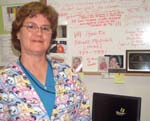Nurse anesthetists grow along with ORs
by Mary
Helen YarboroughPublic Relations
A lot has changed in the 34 years since Susan Owens first entered the nurse anesthesia field. The supervision, the responsibilities, the workload, and the growing expertise among nurse anesthetists in the medical field have expanded along with health care services.
For Owens, some of the more dramatic changes were illuminated in what hospitals in this area were able to offer, and how services have expanded overall.
 Susan Owens is
MUSC's chief nurse anesthetists.
Susan Owens is
MUSC's chief nurse anesthetists. As MUSC’s chief nurse anesthetist, Owens is in charge of 45 certified nurse anesthetists, (CRNAs). Twelve more CRNAs work in Ambulatory under Linda Dancy. But all of these CRNAs participate in about 15,000 anesthetic procedures a year, Owens said.
Owens came here from Charleston Memorial Hospital (formerly Charleston County Hospital) in 1996. A couple of years after she came on board, then chief nurse anesthetist, Bettie Spencer, went out on sick leave for awhile. Spencer is fine these days, but Owens continued in the chief nurse anesthetist post, and will retire in June.
Owens talked about the transition through the years and the amount of change she experienced during her transition between hospitals, and during her stint here.
Ten years ago, MUSC had 20 CRNAs. Now, there are 45 in the main operating area and 12 in the ambulatory operating area. The growth in the demand for CRNAs resulted from the expansion of operating room (OR) services and non-operating room services, Owens said.
“We went from three ORs at Charleston Memorial to about 22 at the Medical University,” Owens said. “It was amazing. We had eight [ORs] in ambulatory, and 14 in the main. Now we have 21 in the main hospital, seven in ambulatory with two procedure rooms; and we have six periphery (non–operating room ) teams a day covering up to 20 plus sites.”
When Owens was at Charleston County Memorial Hospital, the CRNAs were supervised in the beginning by the chief surgeon, Bill Rambo, M.D. “It was a big to-do,” she said. “We had a lot more responsibility, and we depended on each other for help. We worked as a team. We had a stellar group, and I had a wonderful mentor, Alta Sullivan. She kept the anesthesia department together. After about 10 or 12 years, the hospital hired anesthesiologists to work with us. That helped reduce the stress level.”
In July 1996, the operating rooms were closed and some of the CRNAs transferred to the Medical University.
At MUSC, CRNAs still work as a team. “They are exceptional. The cases can be so complicated,” Owens said. “The patients we get here often are referred, and very sick with many co–existing diseases. Their care is a challenge for everyone; therefore you have to have a team approach. We have great support from the CRNAs, Residents and Anesthesiologists.”
Years ago, Owens said the big challenge was departments were thin at her former hospital, which has been converted to accommodate long term care and dialysis patients. There was no neurosurgery, or pediatrics or heart unit, she said. “It was exciting to get in here and do those kinds of cases. I have always liked the challenging cases,” she said.
Then her job got more complicated, more into administration and less into clinical. “I couldn’t do both well, so I stuck to the administrative side,” Owens said.
She also participated in helping design the new hospital that currently is under construction. “I, along with other CRNAs, helped with recommendations on how to design the anesthesia work room, the carts and equipment, and the anesthesia equipment needed for the operating rooms and non-operating areas,” Owens said.
Friday, May 12, 2006
Catalyst Online is published weekly,
updated
as needed and improved from time to time by the MUSC Office of Public
Relations
for the faculty, employees and students of the Medical University of
South
Carolina. Catalyst Online editor, Kim Draughn, can be reached at
792-4107
or by email, catalyst@musc.edu. Editorial copy can be submitted to
Catalyst
Online and to The Catalyst in print by fax, 792-6723, or by email to
catalyst@musc.edu. To place an ad in The Catalyst hardcopy, call Island
papers at 849-1778, ext. 201.